What is the significance of the red dress?
You know the dress I’m talking about. The dress. The red one. The woman wore it, the woman who you weren’t sure if you should trust or not, the woman who had everyone’s eyes on her. The red dress that was cut—well, you remember how it was cut.
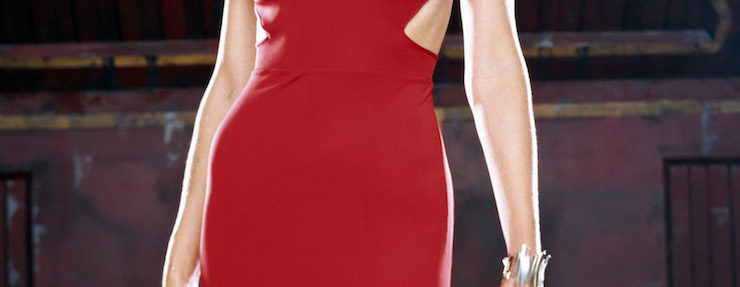
What is it about the white robe?
Yeah, that white robe. Or was it a cloak? You remember? The one that character wore? The character who was really powerful and tough-as-nails and fierce? The character who was occasionally in danger, sometimes in grave danger, but who never flinched? That white robe. Yeah, that one.

Why the black tank top?
It’s so simple, but it’s important. It holds up okay to the scads of abuse it takes. And dang, it takes some abuse. Do you think it’s the reason we knew that she would survive in spite of all the odds? Do you think it’s the source of her unflinching badassery? She wouldn’t be the same without it, that’s for sure.
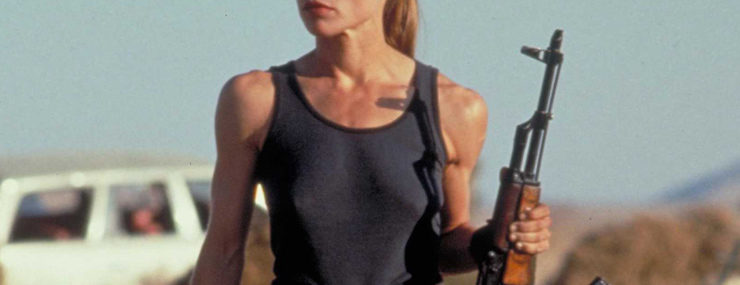
The leather jacket.
The trenchcoat.
The cloak.
The headdress.
The scarf.
The gloves.
The shoes.
Every piece of a character’s costume is a word in a conversation between the creator and the audience. Whether the clothing choices are made by a costumer, a director, or a writer, each decision guides the assumptions and internal narrative of whoever is consuming the media in question. That guidance can highlight characters in obvious ways, like a black cape and a big scary helmet indicating “bad guy.” It can also render them subtly disquieting, like a pink cardigan thinly masking the abject evil of the wearer. Costume choices can be used to unsettle, to misdirect, to shock and to seduce a reader or a viewer. They build the character in the mind of the viewer or reader, paving the way for that character’s story by setting up sweeping assumptions that can then be reinforced or overturned, depending on the goals of the creator.
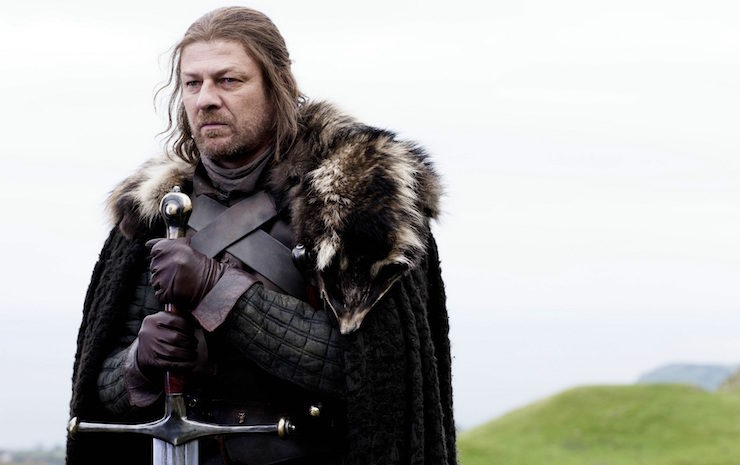
For a simple example of this, consider Ned Stark’s cloak and tunic from the first episode of Game of Thrones. Assume that the viewer knows nothing about Ned, A Song of Ice and Fire, or George R. R. Martin’s homicidal authorial tendencies—they’ve just tuned in for the first time, and they see Sean Bean in a cloak holding a big sword and staring into the middle-distance. That cloak—and the attendant underpinnings thereof—provide several cues that tell the viewer about the world he lives in.
A quick visual scan makes a significant statement. There’s fur—a whole pelt, in good condition. There’s quilting. The cloak is heavy and worked, while the tunic is worn to whiteness in places. There’s a leather vest in a tone so neutral as to fade almost completely from view under the other more prominent details of the outfit.
These visual touchpoints signal the following: this man is outside in the cold a lot. The cloak says that he can afford to look good while he’s out in the cold, the fur says that he’s proud, and the tunic says that he’s more practical than vain. This is a guy who knows how to get through the winter.
With one glance at Ned Stark’s outfit, the viewer has an idea of how he moves in the world he lives in. The costumer and director have worked together in this scene to prepare the viewer for a story about a proud, practical man who is grimly prospering in an unfriendly world. This simultaneously sets expectations correctly (who Ned Stark is and what he does) and primes the viewer for a huge, unpleasant surprise (what happens to Ned Stark when his pride and practicality turn his prosperity into his grave misfortune).
Lazy costuming is always readily evident, because it ignores the world in which the characters live. For example: every gorgeous thing Padme Amidala wears.

Her costuming is never boring, thoughtless, or obvious—costumer Trisha Biggar’s creativity and ingenuity shines in nearly everything Padme wears, and the outfits are very nearly overripe with referent details and internal significance. Regardless, the disjointed extravagance of Padme’s clothing has nothing to do with her character arc, the world she inhabits, or the practicalities of her life. (Of course, one could argue that the ornate, overwrought parade of outfits she wears throughout Episodes 1-3 are their own kind of signal to the viewer: these movies are going to be a lot, try not to think about anything too much, UNLIMITED BUDGET!! One could argue that. But I digress.)
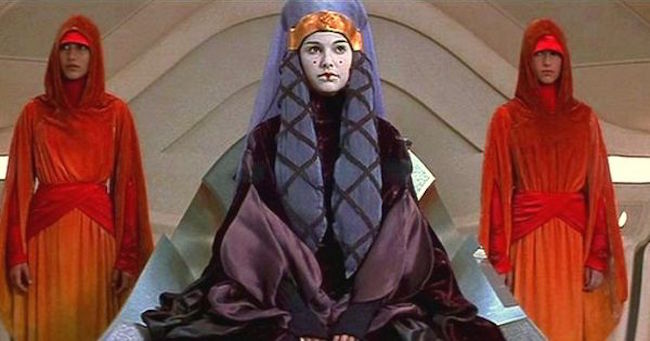
By examining the messages that clothing sends to readers and viewers, creators can find shortcuts that allow for narrative expediency—or narrative deception. By casting a savvy eye over the outfits our favorite characters wear, viewers can start to decode the messages that creators are trying to send them.
Over the next two months, I’ll explore a few of the iconic costume pieces of genre fiction, how they helped to tell the stories we know and love, and how those stories and characters inform the battles we fight today. The world is burning and everything hurts, but damn it, we still have the red dress, the white robe, the black tank top. Fearlessness, courage, and survival: it’s all in the costumes.
 Sarah Gailey’s fiction has appeared in Mothership Zeta and Fireside Fiction; her nonfiction has been published by Mashable and Fantasy Literature Magazine. You can see pictures of her puppy and get updates on her work by clicking here. She tweets @gaileyfrey. Watch for her debut novella, River of Teeth, from Tor.com in May of 2017.
Sarah Gailey’s fiction has appeared in Mothership Zeta and Fireside Fiction; her nonfiction has been published by Mashable and Fantasy Literature Magazine. You can see pictures of her puppy and get updates on her work by clicking here. She tweets @gaileyfrey. Watch for her debut novella, River of Teeth, from Tor.com in May of 2017.










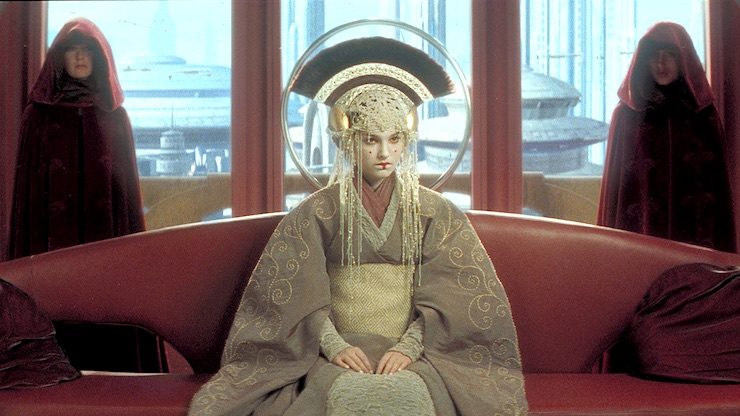
Good article. Looking forward to future installments!
I find Padme’s costumes very symbolic of a more decadent time; especially as contrasted with her attire as a handmaiden, and later a senator (in which her clothes are still elaborate, but a bit more functional), as well as the costumes she wears when not operating in either capacity. As the young queen she basically ends up being manipulated and, perhaps not a figurehead, but a tool for Palpatine to use and hide behind.
Actually, Queen Amidala’s outfit serves a purpose in the story – the viewer is so focused on the trappings of her elaborate outfit and her heavy makeup that they don’t realize that they never see the queen’s real face. Hence the ease in which her handmaiden is able to take her place in the story.
Note also, the look alike outfits that her handmaidens wear – the queen is able to disguise herself to look like one of them because of their outfits and their similar, fresh-scrubbed faces.
Would any of this work in real life? Maybe; there are many studies showing that people can’t recognize someone if they change a little detail, such as a beard or hair color.
This is exciting! Costuming is always interesting. I like when you get DVD extras where you see an interview with a costumer, hear them talk about the passion and care that was put into each outfit, the reasons behind each choice.
Looking forward to future installments!
@3, I agree. Even watching for the switches, it is hard to see when Padme is the Queen and when she isn’t.
@3 Also agreed. It’s quite a clever but subtle tactic. It’s really kind of interesting how there are several swaths of the movie where the queen and handmaiden are switched and you don’t realize it (although on a meta level I suppose it’s a bit spoiled by knowing who Natalie Portman is and realizing that despite being advertised as being cast as ‘the queen’, you know she’s the one hanging around with the Jedi on Tatooine if you recognize her).
Actually my one nitpick is that it’s also spoiled if you know how to count. The queen has 3 handmaidens accompany her to Coruscant, and when Anakin goes to say goodbye to Padme, the queen says Padme is on an errand, but there are clearly 3 handmaidens in the room. But perhaps they weren’t thinking about lovesick little boys, and clearly nobody thinks to question it so maybe they just assume nobody is paying attention to the handmaidens.
Ugh, that red dress is tickling my mind. I’m on the cusp of remembering but I can’t get over the hump. Can anyone take pity on me and help me out?
@6: Clue’s in the file name: it’s Number Six’s dress from the Battlestar Galactica reboot.
@7 – of course! Man, that’s a relief. Thanks!
Costume has always been one of my passions so I’m really looking forward to this series! Thanks for this!
As for Padme, George Lucas specifically demanded that her court costumes should be very stylized and ritualistic and “so big and self-supporting that the queen could slip out the back in the middle of an audience and no one would notice”. I think they filled the bill.
I can answer it. From the look of the rest of the garment, it is quite hard to get off if you are caught in need of pee. Those bulbs must be containers, which means that there must also be a Royal Catheter Fitter on the Nabooian Royal Staff.
#10 @random22 – What part of “Some questions aren’t meant to be answered” was confusing to you? :-P
I could say that now I’ll never watch that movie again in the same way, but the truth is that I’ll probably never watch that movie again regardless.
(Seriously, I lol’d.)
I hope you’re going to include the brownish coat and the ultimate [and much replicated] tri-colour knitted hat from ‘Firefly’ (at least!).
The long [leather] duster coat. That’s graced many a pair of shoulders….
I’m looking forward to this series!
@12, man walks down the street in a hat like that and you know he ain’t afraid of nothing…
@6 I couldn’t think what it was, either. I could only think of the Woman in Red from The Matrix.
PLEEEEEEEASE do Babylon 5!! So much costuming to work with!
I love the “making-of” extra material DVDs for LOTR and The Hobbit at least as much (if not more) as the actual movies (regarding those, if possible, pick the extended editions, they have so much extra stuff. I mean, huorns! Houses of Healing!). One thing I remember vividly from the LOTR ones is how the costuming department (lead by Ngila Dickson, I think, but I might be mistaking) showed and talked about their job. Of how the cuts and material and accessories all had to be distinct to their race and status, how they had to commune with the viewer (much like what was said in the Ned example in the article), of how even all the costumes had their own stories to tell. I remember them showing proudly some elaborate (handmade?) embroidery that might have even been on Theoden’s undergarment or some such and them saying along the lines “Oh, we know that the viewer will probably never see it. But WE know it’s there, and so does the actor, and that’s what makes all the difference for us.” That’s how you know people’s hearts are in their work :) That is also one of the reasons I appreciated PJ’s use of HFR with The Hobbit, I could actually see all these beautiful patterns on the clothes.
It’s not for naught they say “clothes make a man,” and for movies (as well as television and books), one might break all the illusion if you aren’t able to look past the character’s poor choice of garment (or rather, the costume designer’s ).
This is bound to be an interesting series of articles. With some others starting or already ongoing, I fear I will have no free time besides reading tor at all :)
@10. and @11.
The pod things are actually lights. They’re extravagant and look pretty. That’s much of their point.
The costuming in LOTR, for example, was very well thought out. The lightness of the elven tunics, versus the heaviness of the dwarven outfits – it definitely helped define where those characters lived and the complete opposition of their backgrounds.
Some costumes take on a life of their own: Picard’s Star Trek costume and the “Picard” maneuver is a prime example of this!
Great article – can’t wait for the next installment!
@18 Wait, you are saying that Padme has luminous pee?
@17 – my husband and I watch ALL of the special features (even on the Hobbit DVDs, even though I didn’t enjoy the latter two movies as much, I love hearing about all the detail that went into it) and I remember that exact moment. In fact, I think of it whenever Théoden is on screen!
Love it! Costuming is such a key element of storytelling, and one that viewers ALWAYS take for granted. Until you have to put on a production yourself, and you realize how much the costume can make or break a scene! Much like music… it’s there, and your subconscious recognizes it, but unless it’s bad you tend to not think about it.
I’m very much interested in more wardrobe analysis!
I agree with #3. the costumes do play a role in the story, aiding win the anonymity of Padme as well as establishing what kind of society she lives in. Everything about those queen costumes screams decadent society, top-heavy aristocracy. There are similar types of clothing in Earth history that reflect the society that created them, looking at some of the ensembles from late medieval Japan or China, or even some of the Haute Couture excesses of the late 80’s in Europe, they could give Padme’s outfits a run for their money. Also, given what we know about Padme, we are also told by the costumes how much she as a person is constrained by them, and by extension by the society she lives in.
Costuming will make for some incredible articles! Totally disagree with the author about Amildala/Padme costuming though. I always took it as her way of splitting the public/political figure and the true self. She was meant to be a figurehead with only intellectual presence, no physicality, as the queen so dressed in impractical outfits that would imply her status. They also helped her sneak away when, in the handmaidens garb, she was able to move freely and have the ability to gather the information her intellectual role required and freeing her to be her true self.
I get the impression that a lot of people are misunderstanding the author’s point about Padme/Amidala’s costumes. The problem isn’t that she has stagey costumes designed so that the role of the Queen can camouflage the woman inside, and allow her to play shell games with her attendants – as everyone’s said, there is practical purpose to that (especially given Naboo’s habit of electing teenagers as their monarch).
The costume problem is that she has at least four of those massive set-piece costumes in the first film, and they have no internal cultural consistency that tells you anything about her or the planet she comes from.
They’re undeniably gorgeous, taken separately (and Natalie Portman wears them well, and acts her socks off in them). But taken as a whole, they’re a confusion of contradictory features taken from half a dozen historical cultures at different stages of development; merely a patchwork of the most extravagant features that the costumers fancied. Light fabrics in intricate textured layers vs. vivid, heavy fabrics on a sculptural framework vs. shapeless dark drapery. They don’t hold together as a thematic capsule collection and they don’t tell the audience anything about Naboo culture or character. Similarly, there’s no cultural continuity between the handmaidens’ costumes and the Queen’s, or further, to Padme’s Greco-Roman/Art Nouveau senatorial robes in the second and third films. Yes, there are different social classes at play, and the various clothes have different purposes and different characters – but you would expect there to be details and features in common, and there aren’t (except in the shallowest sense of “Padme’s clothes are all extravagant and OTT”).
That lack leaves the viewer with little in the way of visual feedback, compared to Ned Stark’s clothing where every layer adds to the depth with which you view the character, or the detailed cultural consideration and world-building that went into the various Lord of the Rings costuming decisions. As a result, Padme Amidala feels a flatter, more two-dimensional character.
One thing I find striking about male costumes in SF movies is that they push creativity in a way that actual clothing designers never attempt. Men’s clothes in the shops are always dull, predictable, formulaic: Oh look, someone has changed the colour of the buttons or stitching on a shirt. Whoop-de-doo.
But science fiction somehow unlocks creativity – and practicality – to produce outfits that look different, cool and interesting, as well working in the real world (ironically). OK, so the low-slung blaster holster may have to go, looking a bit out of place in my local supermarket, and I’m not sure I could get away with calf-length Han Solo boots while buying my milk and orange juice. But that’s because every other bloke is in jeans & t-shirt or sportswear.
I agree that Queen Amidala’s costumes made very little sense. However, I remember being struck by the similarities between the handmaids red outfits and the uniforms of the Emperor’s guard in the original trilogy.
If you’re taking suggestions (and you’re willing to do non-movie/TV costumes), one of the costumes that came to mind for me was the all-white leather of the Heralds of Valdemar. Arguably they can be kind of boring — what can you do when everything’s white? — but they do achieve their purpose of making their wearers stand out. This is occasionally lamp-shaded; a prominent character in one of the side-series calls it their “oh-shoot-me-now” outfit, or something of the sort. Another one needs to replace her uniform at one point, and she’s coaching the person making it that it has to be “white. Not eggshell, not ecru, not off-white, but white.” (Quoted from memory, may have it a bit off.)
Anyway, they’re a neat costume, and achieve their purpose by being iconic and simple, rather than complex.
@25 Sorry Nic, I believe you are wholly incorrect.
Just because costumes don’t follow history perfectly doesn’t mean they don’t “make sense”. Why would a fictional universe’s culture have to follow our real life Japan’s culture, or any existing country? Just because it’s a “hodgepodge” of real-world stuff doesn’t mean it doesn’t “make sense” for a completely made up universe!
Also, as many others noted, its tell us PLENTY about her culture. It doesn’t matter that one outfit is black and flowy and the next is red velvet. That doesn’t matter. What does matter is that they’re all extravagant, ornate, and unwieldy. Which is all we need to know about what it is being Queen there.
And I don’t know why anyone would expect “similar elements” to hold together between a queen vs her handmaidens’. Once more, just because it sometimes happens in RL doesn’t mean it has to in a fictional universe. Maybe this culture specifically doesn’t want those outfits to be anything alike. To extend even further, maybe the queen’s constant change in garb style is part of the deception. It’s so drastically different every time it’s hard to look past those details and at the person beneath.
So as much as I really hate to defend anything about the prequels, I would say Amadala’s costuming serves its purpose just fine, and informs exactly what it needs to.
Coincidentally, the media analysis website The Fandomentals also announced the start of a series about costumes, this one focused on Game of Thrones and what happens when costume designers headcanon stuff that the essay authors (who strongly dislike the show’s recent seasons) deem neither necessary nor believable: https://www.thefandomentals.com/game-of-thrones-storytelling-confusion-permeates-costume-design/
I realize you’re not talking about prose, but I can’t resist pointing out that illustrators also communicate
Robert Heinlein wrote a famous SF novel about a costume: Have Space Suit, Will Travel.
Ed Emshwiller showed us what it looked like in magazine (see also here) and, later, hardback covers.
Many other artists have followed since 1958, but the Emsh version will always the the most real to me.
@25 – Nic: Even if it’s Star Wars, there won’t be a single culture in one planet. The different kinds of costumes worn by Padme and the handmaidens could represent different cultures in Naboo, or even different eras in the planet’s history.
I did notice the lack of cultural consistency in Naboo costuming. It would have been nice if they’d picked a theme and stuck to it.